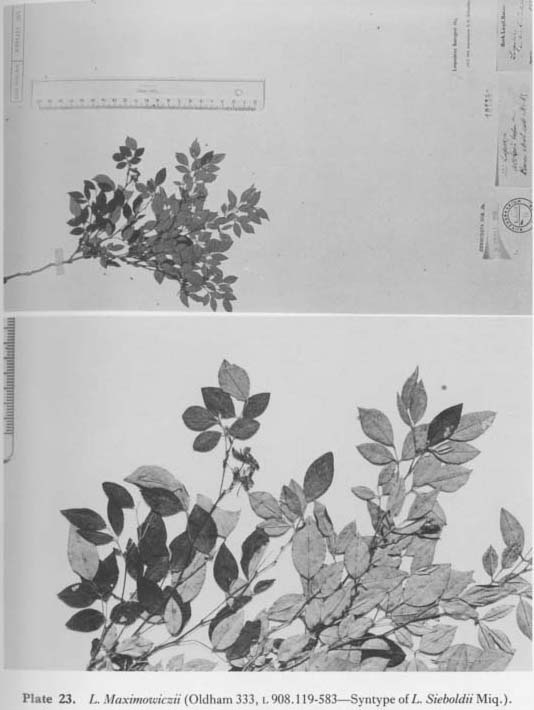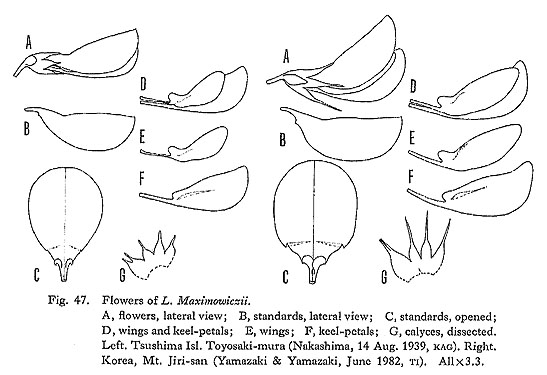Systematic Treatments
L. Maximowiczii Schneid.
Lespedeza Maximowiczii Schneid.Ill. Handb. Laubholz. 2: 113, fig. 70i, 71h-i2 (1907)-Momiyama in Journ. Jap. Bot. 9: 129 (1933), ut "Maximowicziana"-Ohwi, Fl. Jap., 678 (1953); Fl. Jap. rev. ed., 789 (1965); Fl. Jap. Eng. ed., 559 (1965); Fl. Jap. new ed., 789 (1975)-Kita-mura & Murata, Col. Ill. Herb. Pl. Jap. 2: 99 (1961)-Kung in Chinese Journ. Bot. 1: 21 (1963)-Kitagawa in Journ. Jap. Bot. 45: 123 (1970)-Lee in Bull. Seoul Nat. Univ. For. No. 2, 22 (1965); Ill. Fl. Korea, 468 (1979)-Kitagawa, Neo-Lineamenta Fl. Mansh., 406 (1979)-Ohashi in Satake et al., Wild Fl. Jap. Herb. 2: 205 (1982). [Plate 23; Figs. 47 & 48]
L. Sieboldii Miq. in Ann. Mus. Lugd.-Bat. 3: 47 (1867), pro parte, quoad specim. Oldham 333 et Prol. Fl. Jap., 235 (1867), pro parte. L. Buergeri (non Miq.) Maxim. in Acta Hort. Petrop. 2: 353 (1873), pro parte-Palibin in Acta Hort. Petrop. 17: 65 (1898)-Nakai in Journ. Coll. Sci. Univ. Tokyo 26 (Fl. Koreana I): 154 (1909). L. bicolor (non Turcz.) Forbes et Hemsley in Journ. Linn. Soc. 23: 179 (1887), pro parte. L. bicolor Turcz. var. intermedia (non Maxim.) Palibin in Acta Hort. Petrop. 17: 64 (1898). L. Buergeri Miq. var. Oldhamii (non Maxim.) Nakai in Journ. Coll. Sci. Univ. Tokyo 26 (Fl. Koreana I): 154 (1909). L. Buergeri Miq. var. praecox Nakai in Bot. Mag. Tokyo 25: 55 (1911); in Journ. Coll. Sci. Univ. Tokyo 31 (Fl. Koreana II): 467 (1911). L. Friebeana Schindl. in Fedde, Repert. Sp. Nov. 9: 514 (1911); in Sargent, Pl. Wils. 2:111 (1914), typum non vidi. L. praecox (Nakai) Nakai [Catalog. Sem. L. tomentella Nakai, Veg. Isl. Wangto, 16 (1914), in nota sub L. Friebeana, nom. nud.-Makino & Nemoto, Fl. Jap., 735 (1925). L. Buergeri Miq. var. tricolor Nakai, Veg. Isl. Wangto, 9 (1914), nom. nud. L. praecox (Nakai) Nakai var. tomentella Nakai, Veg. Diamond Mts., 176 n.379b (1918), nom. nud. L. Oldhamii (non Miq.) Nakai in Bot. Mag. Tokyo 33: 202 (1919). L. Oldhamii Miq. var. tomentella Nakai in Bot. Mag. Tokyo 33: 203 (1919). L. Oldhamii (non Miq.) Makino et Nemoto, Fl. Jap., 735 (1925). L. Oldhamii Miq. var. tricolor Nakai in Bot. Mag. Tokyo 37: 78 (1927). L. Maximowiczii Schneid. var. tomentella (Nakai) Nakai, Lesp. Jap. Korea, 39 (1927). L. Maximowiczii Schneid. var. elongata Nakai, Lesp. Jap. Korea, 40 (1927). L. Maximowiczii Schneid. var. tricolor (Nakai) Nakai, Lesp. Jap. Korea, 40 (1927). L. densiflora Uyeki in Bull. Nat. Hist. Soc. Corea 20: 17 (1935), typum non vidi. L. Buergeri Miq. subsp. praecox (Nakai) Hatus. in. Mem. Fac. Agr. Kagoshima Univ. 6:6(1967). L. Buergeri Miq. subsp. praecox (Nakai) Hatus. f. tomentella (Nakai) Hatus. in Mem. Fac. Agr. Kagoshima Univ. 6: 6 (1967). L. Buergeri Miq. subsp. tricolor (Nakai) Hatus. in Mem. Fac. Agr. Kagoshima Univ. 6: 6 (1967). Japanese name. Chosen-kihagi (Nakai, 1914). A perennial plant, 1-3 m high, branched in upper parts. Branches terete, spreading, sometimes dependent; when young slightly angular with ascending, spreading, or ascending appressed-sericeous hairs (hairs 0.3-0.6 mm long, yellowish), later glabrescent; most distal parts die in winter, proximal parts (and stem) with axillary winter buds (winter buds at lower parts mostly dormant). Leaves trifoliolate, petiolate, stipulate, alternately arranged (phyllotaxy 1/2). Stipules free, linear-triangular to linear, 2-7 mm long, brownish, persistent. Petioles 0.5-4 cm long, almost glabrous. Rachides 5-15 mm long, similar to the petiole. Terminal leaflets (at middle parts of branches) petiolulate; petiolules 1-2 mm long, swollen; lamina 1-5 cm long, 0.5-3 cm wide, entire, ovate, round at the base, acute at the apex (the apex itself with a point), upper surface glabrescent (except along midrib) or sericeous (hairs ca. 0.5 mm long) at anthesis, lower surface appressed-sericeous (hairs ca. 0.5 mm long, yellowish); lateral ones similar to terminal but somewhat smaller. Inflorescence axillary racemous, one (rarely 2-3) per axil, 2-4(-10) cm long including the peduncle, somewhat compactly to loosely 4-12-flowered; peduncles 1-2(-4) cm long, hairy like the young branch. Primary bracts ovate, about 1 mm long, pubescent, persistent; secondary bracts similar to primary ones. Flowers 9-10 mm long at anthesis; pedicels 0.8-2 mm long, terete, curved, tomentose. Bracteoles at the base of the calyx ovate to elliptic, ca. 1.5 mm long, pubescent outside, glabrous inside, persistent. Calyx 4-5 mm long, campanulate, four-lobed above the middle part, appressed pubescent; tube ca. 1.5 mm long; lobes subequal in length or the lower one longest; lateral ones ca. 3.0 mm long, ca.0.7 mm wide, triangular, acuminate at the apex; upper one two-clefted. Standard shorter than keel-petal and longer than wings, keel-petal longer than wings (K>S>W). Standard red-purple inside, paler outside, ca. 9 mm long with distinct claw, ca. 6 mm wide; lamina round to elliptic or broadly obovate, round or retuse at the apex with or without mucro, inflexed-auriculate near the base, spreading in anthesis from the part near the base; auricles developed; claw whitish, ca. 1.5 mm long. Wings deeper red-purple, ca. 8.5 mm long with distinct claw; lamina narrowly oblong, ca. 6.5 mm long, ca. 2.5 mm wide, auriculate at upper basal part; claw ca. 2.5 mm long, whitish. Keel-petal ca. 9.5 mm long with distinct claw; lamina obovate, ca. 7.0 mm long, ca. 3.0 mm wide, paler than wings, deepest in the apical part; claw ca. 3.0 mm long, whitish. Stamens 10, nearly the same length, ca. 9.0 mm long, diadelphous. Anthers elliptic, shallowly retuse at the apex, ca. 0.5 mm long; before anthesis yellow. Pistils ca. 9.3 mm long; ovary elliptic, ca. 1.8 mm long at anthesis, pubescent, stalked; stalk ca. 1.3 mm long; style ca. 6.5 mm long, pubescent at the basal part, glabrescent at the apical part. Fruits compressed, round or broadly elliptic, ca. 1.5 mm long, ca. 5 mm wide, subsessile, slightly to densely pubescent or nearly glabrous. Seeds reniform, 3-4 mm long, 2-3 mm wide. Distr. Japan (north of Tsushima Island), Korea, and China. Specimens examined. Japan or Korea (ut "Japan & Korean Arch. coll.") (Oldham 333, L 908.119-583-Syntype of L.Sieboldii Miq.). Japan. KYUSHU. NAGASAKI. Isl. Tsushima. Toyosaki-mura (Nakajima, 14 Aug. 1939, KAG); Toyosaki-mura, Toyo (Hara s.n., MAK). Cultivated in Tokyo (ex Isl. Tsushima, Kamiagatagun, Toyo) (Akiyama, 5 June 1984, TI). Korea. Port Chusan (Wilford in 1895, CAL). Wangto (Nakai 592, TI-Lectotype of L. Oldhamii Miq. var. tomentella Nakai; Nakai 600, TI-Lectotype of L. Oldhamii Miq. var. tricolor Nakai). CHOLLANAM. Mt. Jiri San, Rokotan-Kegon-ji (Yamazaki & Yamazaki, 21 Aug. 1982, TI), KYONGSANGNAM (KEINAN). Toksan (Mori 183, TI-Holotype of L. Maximowiczii Schneider var. elongata Nakai). KYONGSANPUK. Mt. Woonmoon (Kim, 10 June 1984, A). KANGWON (KOGEN). Yangyang-gun, Seomyun, Osekoncheon-Sulak San, alt. 700-800 m (Murata & Ko 21084, TI); Kongo-san (Wilson, 30 June 1918, TI). China CHEKIANG. Yen Tang Shan, alt. 500-700 m (Chiao 14735, A). This species is rare in Japan and only known from Toyosaki and Waniura, in the northernmost part of Tsushima Island (Kami-shima), Kyushu. It is abundantly distributed in Korea, especially in the southern parts, and also reported from China (Honan, Chekiang, and Anhwei (Kung, 1963)). L. Buergen is not found in Tsushima Island and Korea. The distribution pattern of these two species is interesting. Hatusima (1967) recognized this species as a subspecies of L. Buergeri. But this is well distinguishable from the latter by calyx-lobes with acuminate apex and red-purple flowers. This species is woody like as L. Buergeri. The direction of hairs varies by branch; inflorescence-axes and young branches have ascending hairs. The degree of hairiness of the upper surface of leaves varies even in the same locality by population or by individual. A typical form with glabrous upper surfaces of leaves is common. A form with sparsely pubescent upper surfaces of leaves is called var. tomentella Nakai. Hatusima recognized this variety as a form and made a new combination under L. Buergeri, therefore, a new combination, L. Maximowiczii f. tomentella, is needed. It is difficult, however, to clearly distinguish this form. from the typical glabrous form, because the degree of hairiness changes gradually. Forma albiflora Uyeki in Journ. Kor. For. Soc., No. 194 (1942), typum non vidi. Corolla white. This is a white-flowered form of L. Maximowiczii. As we cannot examine the type specimen nor any other specimens, the details about this form are uncertain. |



 Spor. Univ. Imp. Tokyo, 20, no. 566 (1914), comb. mud.] ex Koidz. in Bot. Mag. Tokyo 39: 24 (1925).
Spor. Univ. Imp. Tokyo, 20, no. 566 (1914), comb. mud.] ex Koidz. in Bot. Mag. Tokyo 39: 24 (1925).